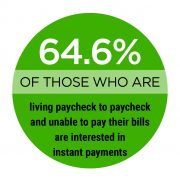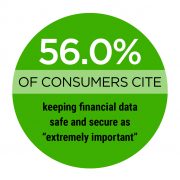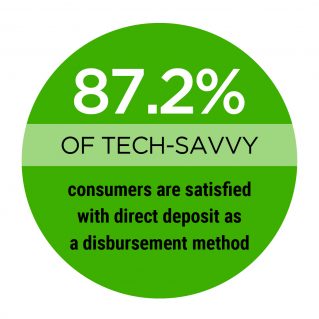What is the key to meeting consumers’ payment preferences? According to a survey of 2,300 respondents, it all comes down to the three Cs: convenience, certainty and choice, the latest edition of the Disbursement Satisfaction Index reveals.

In terms of convenience, speed is priority. When it comes to getting paid, consumers want quick and easy access to their funds – without the common frictions involved with a paper check. In fact, 75 percent of respondents describe speed as very important. Meanwhile, 85 percent of respondents want to be certain their funds are safe and secure, and 47 percent want a choice in where funds are deposited.
As for the method of disbursement, direct deposit maintains its crown as the most popular. Slightly more than half of respondents (53.7 percent) named direct deposit as their preferred disbursement method for recurring payments, with instant payments coming in as the second most popular method (22.4 percent).
 One of the other interesting findings outlined in the Index is how consumers’ personality affects their preference for various disbursement types. To better understand personality differences, PYMNTS focused on three different groups: tech-savvy consumers, millennials between the ages of 25 and 34 and small business owners. PYMNTS research found that tech-savvy consumers preferred direct deposit and instant payment methods, while millennials were less satisfied with receiving their earnings through instant payments.
One of the other interesting findings outlined in the Index is how consumers’ personality affects their preference for various disbursement types. To better understand personality differences, PYMNTS focused on three different groups: tech-savvy consumers, millennials between the ages of 25 and 34 and small business owners. PYMNTS research found that tech-savvy consumers preferred direct deposit and instant payment methods, while millennials were less satisfied with receiving their earnings through instant payments.
Here are some other key data points from the latest Disbursement Satisfaction Index:
Advertisement: Scroll to Continue
- Despite a 7.8 percent drop in consumers’ satisfaction, direct deposit remained the most popular disbursement method for receiving recurring payments.
- Paper checks had a dissatisfaction rate of 14.1 percent, the highest among all payment types.
- Seventy-five percent of consumers who prefer instant payments say speed is the most important factor.
- Among consumers who live paycheck-to-paycheck, 45.5 percent said they were extremely satisfied with instant payments.
To find the rest of the data and insights, check out the latest Disbursement Satisfaction Index™.
Disbursing Aid for Disaster Relief Efforts

From wildfires to tornadoes and hurricanes, a total of 59 natural disasters struck the U.S. in 2017, making it the worst year on record, according to the Federal Emergency Management Agency (FEMA).
The results of these disasters can be catastrophic. Residents of impacted communities can find themselves displaced and face hefty expenses to repair damaged homes or businesses. In response, FEMA is dispatched to assess the damage and provide aid to help victims rebuild their lives. But receiving aid can be an additional challenge for residents who might be unable to occupy their homes or access their bank accounts to make deposits or withdraw cash.
To aid residents more effectively, FEMA uses several different payment tools, including electronic fund transfers (EFTs) and direct deposits to a recipient’s debit card. These options, said FEMA’s Director of External Affairs Alex Amparo, are essential in getting aid to recipients so they can begin the process of rebuilding their lives. Amparo discussed the tools FEMA uses to respond to the financial needs of residents following a natural disaster.
“We want to be able to work as quickly as possible to get resources into the hands of disaster survivors,” Amparo said.
To read the full story, check out the Index.
About the Index
The PYMNTS Disbursement Satisfaction Index™, in collaboration with Ingo Money, is designed to help measure consumer satisfaction with various disbursement methods, including paper checks, instant credit, non-instant credit and direct deposits. The Index offers a microscopic look at the state of consumers’ satisfaction with how they receive disbursements.

